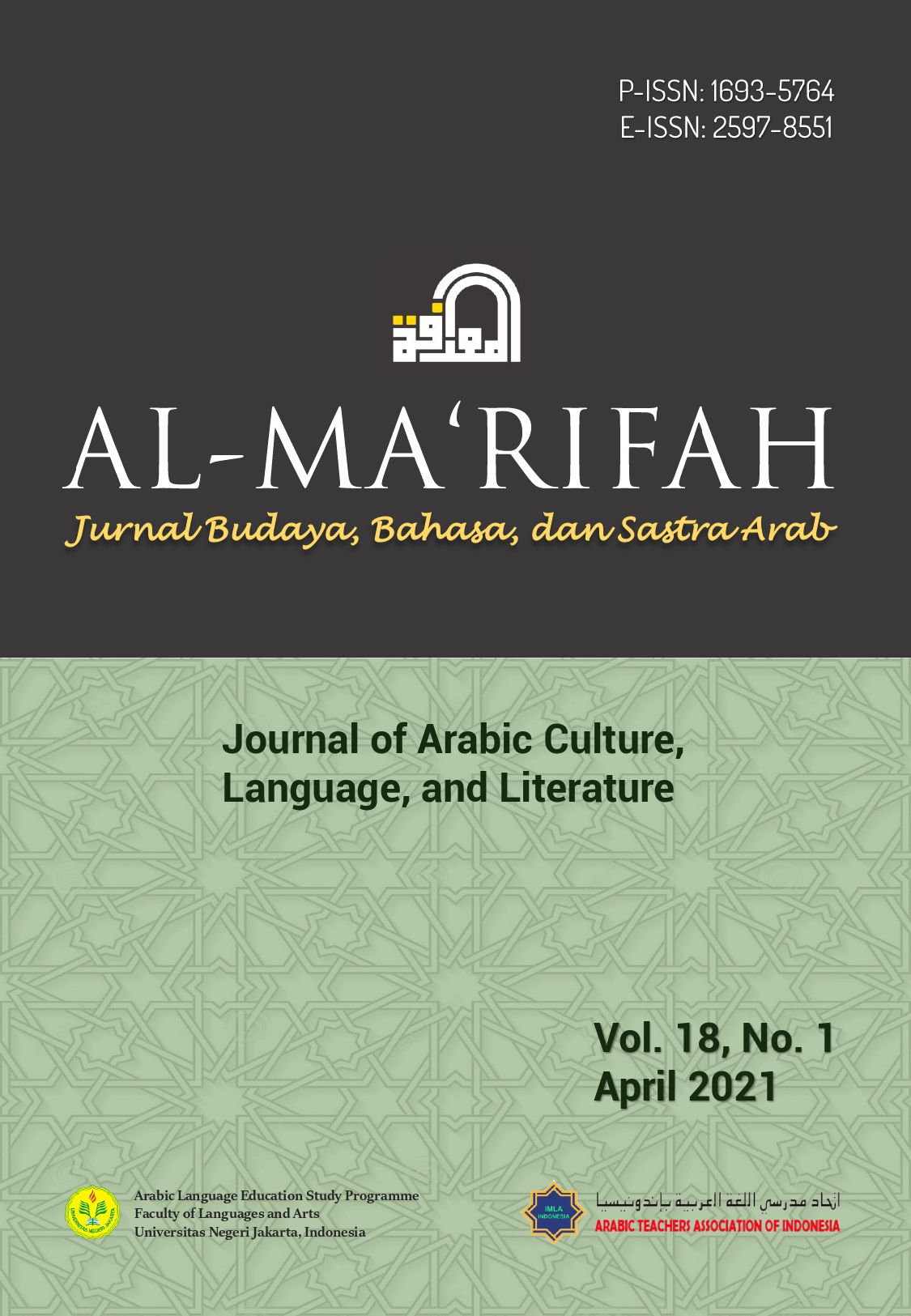Representasi Kerinduan dalam Lagu Umm Kulthūm Qiṣṣat Ḥubb Karya Aḥmad Rāmī: Analisis Semiotik Charles Morris
DOI:
https://doi.org/10.21009/almakrifah.18.01.05Keywords:
Semiotic, the longing of a man, qiṣṣat ḥubbAbstract
The purpose of this research is to reveal the representation of a male character’s longing for his lover in the song Qiṣṣat Ḥubb, a song full of emotion. The song was sung by Umm Kulthum, a famous singer from Egypt who has a big influence in the Arab world. The song Qiṣṣat Ḥubb was composed by an Egyptian writer named Aḥamd Rāmī. In the song Qiṣṣat Ḥubb, some signs have a deeper meaning. The study of meaning in this study uses Charles Morris’s theory of semiotics, which is divided into three, namely syntactic meaning, semantic, and pragmatic meaning. This study used a descriptive-analytic method by describing the data on the object of research, then continued with the analysis. The results of this study indicate that the syntactic meaning in the song Qiṣṣat Ḥubb is the sadness of a man because he reminisces with his late lover. The semantic meaning of this song is the confusion of a man who is abandoned by his lover. Meanwhile, the pragmatic meaning is the longing of a man for his lover which causes suffering and almost drives him crazy.
References
Danielson, V. (1997). The voice of Egypt: Umm Kulthum, Arabic song, and Egyptian society in the twentieth century. Chicago: University of Chicago Press.
Kiram, I. (2019, May 13). Ummi Kulsum: Perempuan pemersatu Arab. Republika. Retrieved from https://www.republika.co.id/berita/pregh6440/ummi-kalsum-perempuan-pemersatu-arab
Lestari, I., Arafah, B., Sahib, H., Makaa, M. (2020). Morris’ semiotic in religion perception and conception in Gane of Polinaki traditional wedding ritual in Kulawi ethnic. Language Literacy: Journal of Linguistics, Literature, and Language Teaching, 4(2), 306–315. doi:10.30743/ll.v4i2.3063
Manshur, F. M. (2011). Perkembangan sastra Arab dan teori sastra Islam. Yogyakarta: Pustaka Pelajar.
Nöth, W. (1990). Handbook of semiotics. Bloomington & Indianapolis: Indiana University Press.
Nöth, W. (2006). Semiotik (A. S. Ibrahim, Terj.). Surabaya: Airlangga University Press.
Petrilli, S. (2004). From pragmatic philosophy to behavioral semiotics: Charles W. Morris after Charles S. Pierce. Semiotica, 148, 277–315. doi:10.1515/semi.2004.011
Pradopo, R. D. (1987). Pengkajian puisi. Yogyakarta: Gadjah Mada University Press.
Qoriah, N. A. (2018). Qaṣīdat al-Ṭalāsim li-Īlyā Abū Māḍī: Dirāsah Taḥlīlīyah Sīmāīyah li-Charles Morris (Skripsi). UIN Sunan Kalijaga, Yogyakarta.
Siswantoro. (2010). Metode penelitian sastra: Analisis struktural puisi. Yogyakarta: Pustaka Pelajar.
Thuraya, T. (2009). Lagu-lagu Ummi Kulsum karya Ahmad Muhammad Rami: Analisis struktur teks dan isi (Skripsi). Universitas Indonesia, Depok, Jawa Barat.
Trabaut, J. (1996). Dasar-dasar semiotik (S. Pattinasarany. Terj.). Jakarta: Pusat Pembinaan dan Pengembangan Bahasa Departemen Pendidikan dan Kebudayaan.
Zaimar, O. K. S., & Harahap, A. K. (2014). Semiotika dalam analisis karya sastra. Depok: Komodo Books.











